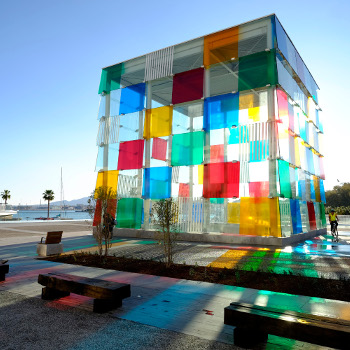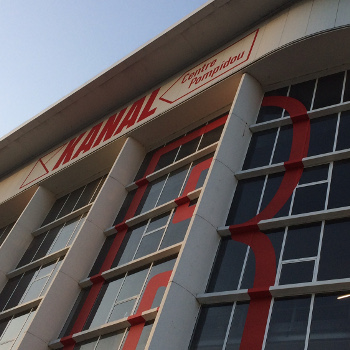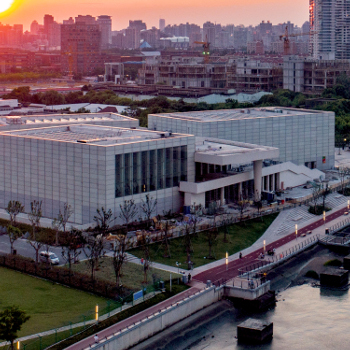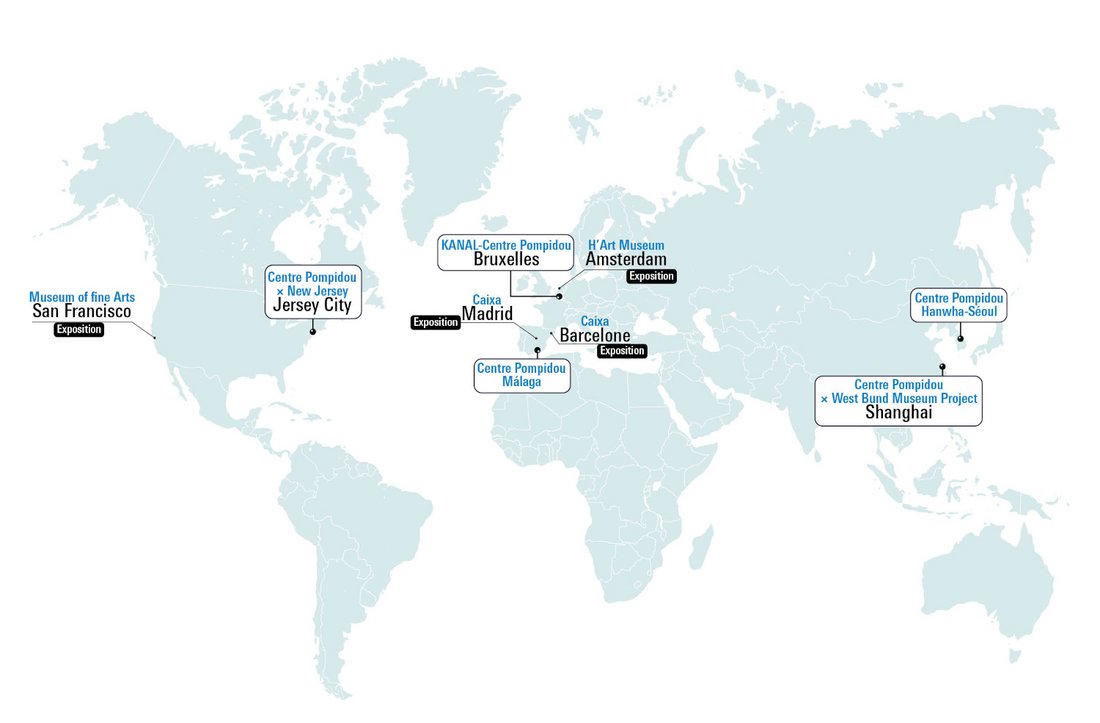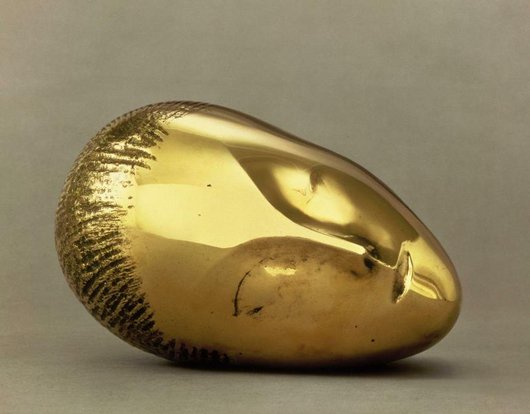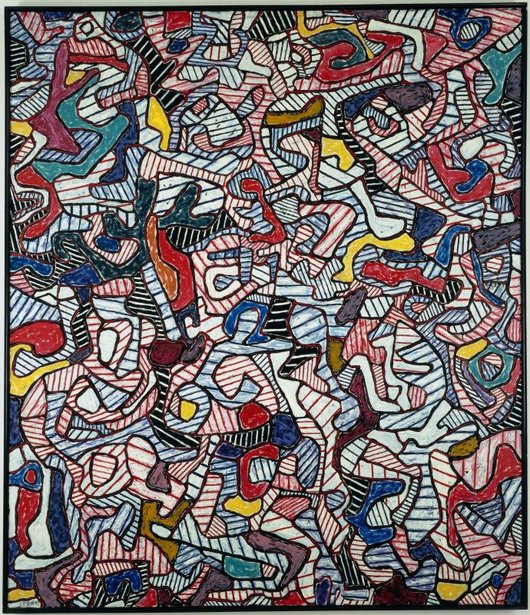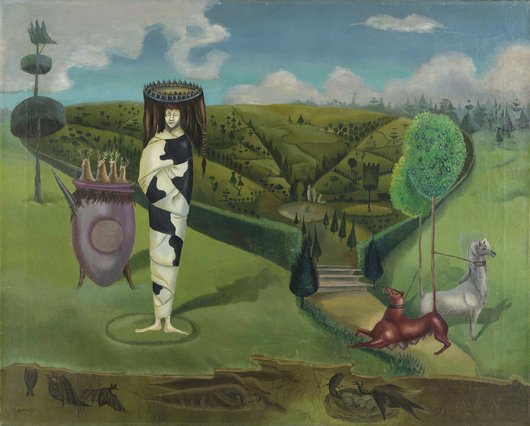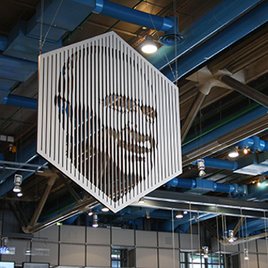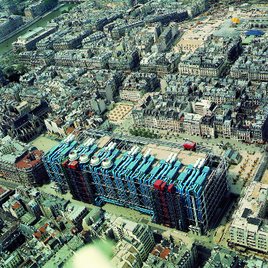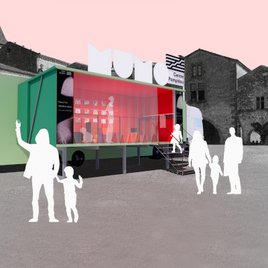International
The Centre Pompidou’s international deployment is an embodiment of the urge to share French culture, in a rich conversation with all international scenes with the vocation of being seen and featuring in the Centre Pompidou – Musée National d’Art Moderne’s multi-disciplinary collection — itself the heir of the Musée des Écoles Étrangères in the early 20th century.
Centre Pompidou Hanwha
Scheduled to open in May 2026
On 27 July 2023, the Centre Pompidou signed a partnership agreement to create a Centre Pompidou Hanwha in Seoul, South Korea. This exhibition area will be located in Tower 63, a building of over 11,000 sq.m, located in Yeouido, in the finance district of the cit. Jean-Michel Wilmotte is in charge of remodelling the interior of this establishment set to open in autumn 2025.
For this novel collaboration, the Centre Pompidou will be putting on a series of eight monographic and themed exhibitions (at a rate of two a year for four years), from the Musée National d’Art Moderne’s modern and contemporary collections. Nearly 1,500 sq.m have been allocated exclusively to these exhibitions on the following artists and movements: Cubism, Marc Chagall, Wassily Kandinsky, Henri Matisse, Georges Braque and Pablo Picasso, Surrealism, Joan Miró and Jean Dubuffet.
In addition to this rich schedule, the Centre Pompidou Hanwha also aims to set up an educational area in the same building for young visitors to explore and interact with the works of art.
This partnership shall run for four years, starting on the opening date of the Centre Pompidou Hanwha.
Centre Pompidou × Jersey City
Opening scheduled for 2030
In early 2025, the Centre Pompidou signed a new memorandum of understanding with Jersey City, one of the youngest and most multi-ethnic cities in the United States, located within the New York metropolitan area.
This partnership, initially set for ten years and renewable, aims to create a multidisciplinary art and cultural center—a new kind of laboratory, both artistic and societal, inclusive and participatory, placing education and community spirit at the heart of its mission.
Centre Pompidou × Jersey City will occupy approximately 8,000 m² spread across six levels within a residential complex of two towers built by KRE Group, located in the historic Journal Square neighborhood, currently undergoing renovation and located just steps from the PATH train. The space will include exhibition spaces, a studio designed to host multidisciplinary programming, several workshops for amateur practice, as well as outdoor areas.
The French teams contribute their expertise in defining the cultural project, designing the building and developing the preliminary programming.
Centre Pompidou x Paraná
Opening planned for November 2027
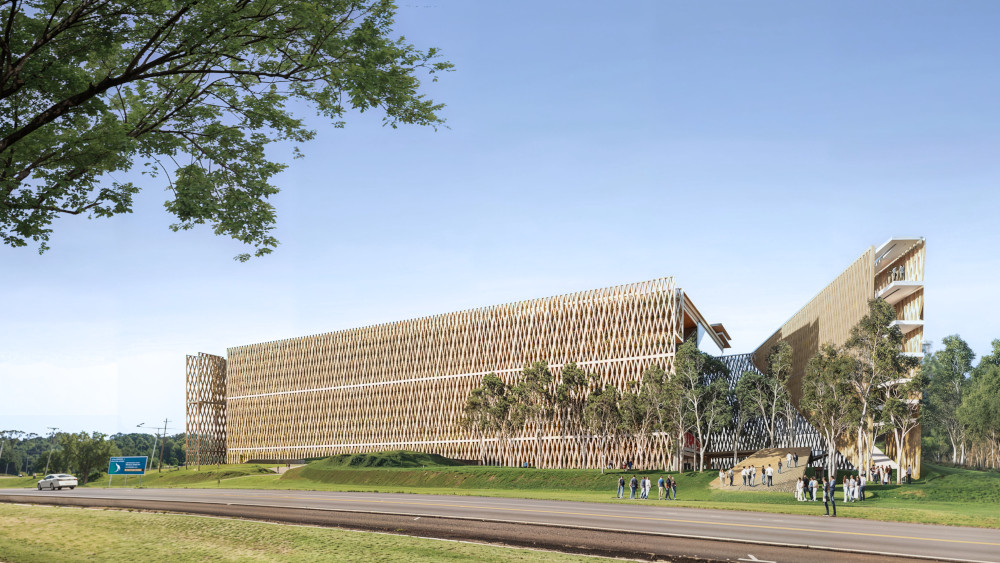
Following an advisory mission initiated in 2022, the Centre Pompidou signed, in spring 2025, a five-year memorandum of understanding with the State of Paraná (Brazil) for the creation of a Centre Pompidou in Foz do Iguaçu.
True to the spirit of the Parisian institution, this new arts center will offer a multidisciplinary program combining modern and contemporary art exhibitions, live performances, film screenings, festivals, talks, and artist residencies. Located in the heart of the Triple Frontier, where Brazil, Argentina, and Paraguay meet, the center will spotlight South American artistic creation and the unique cultural dynamics of the region.
Close to the Iguaçu Falls, a UNESCO World Heritage Site, the center will contribute to both local and international tourism in the area. The future building is designed by Paraguayan architect Solano Benitez, winner of the Golden Lion at the 2016 Venice Biennale. The project, both innovative and environmentally responsible, will echo the iconic Paris Centre Pompidou through its integration of a public piazza.
Cultural engineering
As France’s national modern and contemporary art center, home to one of the world’s two largest collections in modern & contemporary art, Centre Pompidou develops partnerships with museums, art centers, public administrations and private companies.
With decades of experience in travelling exhibitions, co-creating dedicated spaces for art and culture – from Metz in 2010 – as well as designing innovative and local mediation projects, spaces and programmes for public or private partners, Centre Pompidou has acquired a vast array of experiences in all fields of cultural expertise.
Almost 50 years after opening, the Centre Pompidou is embarking on a major renovation programme, both architectural and cultural. As this project will involve closing the building from summer 2025 to early 2030, Centre Pompidou | Constellation is taking over, reaching out beyond its walls and meeting more and more visitors, throughout France and around the world.
This period will therefore be accompanied by a strengthening of the Centre’s international policy. The Centre Pompidou has a long tradition of loaning works abroad, backed up by its exported expertise in heritage presentation and outreach – illustrated in particular by its branches in Malaga and Shanghai – and is embarking on new, tailor-made partnerships and a series of travelling exhibitions based on the excellence of the Musée National d'Art Moderne collection.
Travelling exhibitions
In line with the institutional partnerships which are the Centre’s backbone, a policy of exterior exhibitions has been deployed. This taps into several formats hosted by Centre Pompidou satellites abroad as well as long-standing partners.
The fist Constellation exhibitions have been designed drawing on the unique collections of works by major modern artists, whether French or having settled in France in the 20th century, including Wassily Kandinsky, Marc Chagall, Henri Matisse and Joan Miró. These tours have been designed in symbiosis with exhibitions across the nation.
Brancusi
This exhibition will pay tribute to major 20th-century artist Constantin Brancusi (1876-1957), considered to be the father of modern sculpture. Originating from Romania, Brancusi settled in Paris in 1904 after crossing Europe, and upon his death, chose to bequeath his entire Parisian workshop to France. This project has been put together from this benchmark collection.
The exhibition will show how he exalted simplicity in shapes, all the better to express "the very essence of things", looking beyond mere appearance to achieve a universal language. This quest paved the way to abstract art, yet paradoxically was not devoid of ambiguity. The elementary geometry of Brancusi’s signature shapes (eggs, crosses, spirals etc.) was constantly paced by layering, energised with contrasting materials and the fascinating interplay of reflections that absorbed both the surrounding space and onlookers.
Following the themed circuit of the exhibition, visitors will be able to view major sculptures, repeating the themes and motifs (heads, kissing couples, torsos, female portraits and animals) that the artist was to explore unceasingly for several decades. The exhibition will emphasise both the variety of materials used (bronze, stone, wood and plaster) and the artist’s creative process: direct carving, the aesthetics of fragments, the simplifiction of shapes, the use of plinths etc. The exhibits will be rounded off with a set of films and photoaphy by the artist, highlighting his approach to sculpture as "form in motion".
There may also be a virtual visit of Brancusi’s workshop, fully digitised in HD by the Centre Pompidou. This extra content will give visitors a unique, immersive experience at the heart of a legendary venue for modern art history. In the words of his friend Man Ray: "When you enter Brancusi’s workshop, you enter another world."
Curator: Ariane Coulondre, curator, Centre Pompidou – Musée national d’art moderne
Robert and Sonia Delaunay, endless rhythm
Among the great sets of monographs that make up the Musée National d’Art Moderne’s collection, those featuring the works of Robert and Sonia Delaunay are especially stunning. The collection was put together in close collaboration with the artists, starting in 1935. The "Endless rhythm" project draws on the wealth of this collection comprising paintings, drawings, reliefs, mosaics, book bindings, decorative arts, mock-ups and monumental decors for the 1937 Exposition Internationale des Arts et des Techniques, and many documentary photographs.
The exhibition starts out with the artists' early works, already belying an attraction to pure colour and geometric decomposition of shapes, through to pre-war formal innovations, marked by the abstract layering of light moving through coloured circles. It then continues with the surprising, spectacular and mostly unknown output of the 1920s, during which the Delaunays worked on sets for cinema; Sonia also launched a boutique and a sewing workshop. The two painters also worked in architecture: the works they produced for the Palais des Chemins de Fer and the Palais de l’Air caused a sensation at the 1937 Exposition Internationale in Paris.
Comprising some 60 to 80 works, often in huge, spectacular formats, as well as photographs and film, this exhibition exploes the Delaunays' aspiration as a couple to merge art and daily modern life.
Curator: Angela Lampe, curator, Centre Pompidou – Musée national d’art moderne
Chagall, charting a separate course
The last of the giants from the heroic era of modern avant-gardes, Marc Chagall, expired just two years before his centenary, on 28 March 1985. He was one of the greatest painters of figuative art in the 20th century. And, above all, one of the greatest colourists. Like few others, this Jewish artist managed to blend east and west in an amalgamation of his Russian origins, his memories of his birth town Vitebsk and the pictural innovations emanating from cubism, to form a powerful language, at once simple and complex, in which art and life were intimately mingled. Rejecting all forms of orthodoxy, Chagall ever remained on the fringe of movements, closer to poets than other artists, with an independent style that absolutely cannot be fitted into ay box.
The exhibition will highlight this unique course. In six chapters, it will recount Marc Chagall’s career, starting with his birth in Vitebsk to a modest Jewish family in 1887, with not a hint of his future career as an artist of global repute. The exhibition will feature some 55 paintings and nine sculptures, as well as filmed interviws with Chagall, documentary films and a selection of photogaphs.
Curator: Angela Lampe, curator, Centre Pompidou – Musée national d’art moderne
Jean Dubuffet. Retrospective
As a prolific artist and painter paying no heed to convention, whether in society or art, Jean Dubuffet made non-savoir a principle with which to create a singular body of work, organised as successive series, the most significant of which will be exhibited in this retrospective.
The "first works" that Dubuffet listed as such, those produced as from 1942, showed the painter’s interest for children’s drawings, graffiti and outsider art. He coined French term for outsider art ("art brut") in 1945 to designate the artistic production of people from outside the world of culture. He studied it and collected it diligently, seeking himself to reach this deconditioned state, in order to change the perspective put forward, his vision of things and the world. Parallel to his painting career, he also wrote a founding declaration to explain his "anticultural positions", also showing a preference for the company of writers rather than artists. The portrait of one of them, Dhôtel nuancé d’abricot, 1947, is emblematic of his renouncement of all aesthetic order: characteristic frontality, a clumsy hand, freewheeling use of colour and non-art materials. The series "Corps de Dames", including the dazzling Métafizyx, 1950, empowered the artist to cross another line jeopardising figures in favour of painting, now the subject of the work.
Ever seeking out pictural inventions, Dubuffet illustrated his research in major series: "Matériologies", such as the majestic Messe de Terre, 1959-1960, "Phénomènes", a major set of lithographs produced from 1958 to 1963, "Paris Circus", illustrated by the joyful Rue passagère, 1961, expressing the colourful bustling of the city. Then we come upon a vast series, "L’Hourloupe", which introduced a whole new language, featuring shapes, some coloured in, some hatched, in a limited colour range (black, white, red, blue). "L’Hourloupe" was to occupy Dubuffet for twelve years, from 1962 to 1974.
The artist produced several other major series in the course of his career, such as the "Psycho-sites" and the "Mires", with in particular the stunning, vigorously painted Cours des choses, 1983. Each time he reinvented a vision of the world calling perception into question, through to his ultimate series "Non lieux", wrapping up a radical body of work, among the most audacious in art history in the 20th century.
Curator: Sophie Duplaix, curator, Centre Pompidou – Musée national d’art moderne
Fernand Léger, painter of the modern world
This exhibition will be devoted to the fascinating personality of Fernand Léger, who painted the city and modern life, celebrating the great changes of his era.
Very early on, Fernand Léger noticed the great contrast and intensity of modern life: the sight of the ever-changing cityscape, the noise and speed of machinery and cars, the colour of advertisements on the walls and manufactured products invading shop windows. Initially influenced by cubist aesthetics, Fernand Léger soon broke free from artistic convention and sought to depict this fragmentation of vision and the syncopated beat of a booming society. Renewing himself throughout his career, he reacted to the saturation of images, with a quest for visual impact and colourful audacity, guided by the aesthetic of contrast heightened to the limit.
The exhibition retraces the painter’s career from the 1910s to the 1950s, drawing the portrait of a curious man, fascinated by his times. Featuring around 100 of the artist’s major works, this event explores the ties maintained throughout his career between his output and poetry, film, architecture and the performing arts with his many artistic collaborations. It will also draw attention to the ever-current nature of his painting, seeking to conciliate the requirements of a new plastic language to a truly popular dimension. Many documents from the archives will reveal the various facets of his work and will show the man as he was: the theoretician of painting, the tireless teacher in the workshop that trained many artists, the traveller with unusually keen powers of observation and the artist committed to social progress.
Curator: Ariane Coulondre, curator, Centre Pompidou – Musée national d’art moderne
At home with Matisse
A fresh start for painting: Matisse 20/21th century
LThe exhibition takes visitors on a journey that the artist himself took – following the whims of his influence on homes and lands both real and imaginary in 20th century creation, in contact with the international avant-gardes. With Henri Matisse, as well as after him.
Some 30 paintings, all Matisse masterpieces, have been placed for the fist time alongside a selection of the works from the Centre Pompidou collection. The conversation around this painting "tirelessly started afresh" highlights major figures from the 20th and 21st centuries. From Sonia Delaunay to Natalia Goncharova, not forgetting Daniel Buren, the exhibition aims to explore kinship ties with Matisse which have yet to be imagined. These ties may be contemporary to Matisse like the Russian scene and Jean Pougny (Ivan Puni), or the account of his first trip to Algeria in 1907 and the importance of the notion of global decoration, as reactivated by Baya (née Fatma Haddad).
But the exhibition also hopes to explore the ties addressed in Matisse’s work such as the role of female models as objects of desire in Zoulika Bouabdellah’s work. In the video Dansons (2003), addressing the post-colonial dimension of the feminine imaginary, Bouabdellah suggests another take on the place of women’s creative output after Matisse, via the theme of dance, this most Matissian theme.
"At home with Matisse". One might put forward the hypothesis that the name of the artist is a place in which to live and Matisse is to be understood in his historic dimension as much as in our present, like a perpetual fresh start for painting, this medium that he always used to call the "summit of his desire".
Curator: Aurélie Verdier, curator, Centre Pompidou – Musée national d’art moderne
Mapping Surrealism
The importance of Paris in Surrealism and the ties maintained with André Breton nd his heirs, have helped the Centre Pompidou put together the greatest collection worldwide of Surrealist works. Drawing on this collection, stupendous from all standpoints, the exhibition "Mapping Surrealism" retraces the adventure of this movement, from its invention in 1924 to the last public events held in the mid-1960s.
The exhibition has been designed according to the great poetic principles which shaped the definition of Surrealist inspiration (tapping into the unconscious, dreams, popular art forms and the creation of deviants and "mediums"). It looks back at the technical inventions which made it possible to open creation to these new forces: the invention of "automatic" art, collective activity, the collage technique and the place of objects. The exhibition will retrace the milestones in Surrealist art as it constantly reinvented itself, spreading across the world, from Prague to Mexico and from Martinique to New York. In keeping with the multi-disciplinary exhibitions which have forged the Centre Pompidou’s fame, it will especially highlight the Surrealists' interest in poetry, literature, film and photography.
Curators: Didier Ottinger, deputy director of the Musée national d’art moderne and Marie Sarré, curator, Centre Pompidou – Musée national d’art moderne
Vassily Kandinsky, pioneering abstract art
The work of Wassily Kandinsky (1866-1944), one of the greatest 20th-century artists, has long been considered to be the first expression of non-figurative art in the early 20th century. While it has now been acknowledged that there are multiple origins of abstract art, the decisive contributions of this artist of Russian origin to the idea of "autonomous" art, breaking free from any reference to the outer world, shines through in his theoretical work and in his role as an instigator, publisher and teacher.
Thanks to donations and the succession of his widow Nina Kandinsky, the Centre Pompidou conserves the most complete collection of works by this artist.
This retrospective retraces his extraordinary career in Russia, Germany and France. In five chapters, the exhibition examines his figuative beginnings, the genesis of abstract art in Munich, his return to his birth country Russia during the revolutionary years, his stint as a Bauhaus teacher and his last years in Paris. A major installation will be presented for the fist time in the Netherlands: the reconstruction of a reception hall that Kandinsky designed in Berlin in 1922. This reconstitution offers visitors the impression of actually being part of one of his paintings.
Curator: Angela Lampe, curator, Centre Pompidou – Musée national d’art moderne
New pluri-annual partnerships
To promote collections internationally via travelling exhibitions, two pluri-annual partnerships have been signed, in order to gain a firmer geogaphical foothold for long-lasting satellites alongside partner institutions, optimise the movements of the works in each geographic zone (ecological impact) and the maximum number of stages per project (preventive conservation).
Fundación La Caixa, Spain
Since 2005, Centre Pompidou masterpieces have been showcased on many occasions in the Caixa Forums throughout Spain. The signing of a fist pluriannual agreement in 2019 led to the launch of a large-scale, 5-year programme of exhibitions, each showcased at several venues. In 2023, a new 5-year partnership was signed. An exhibition on Henri Matisse will be on display in 2026 in Madrid and Barcelona followed by a made-to-measure project on Op Art to be presented in Barcelona, Madrid, Saragossa, Valencia, Seville and Palma de Majorca from June 2027 to November 2029.
H’Art Museum, Amsterdam
The H’Art Museum is a new partner having signed up in the context of the closure.
Five major prestigious exhibitions will be presented there from 2024 to 2028: "Wassily Kandinsky" (2024), "Constantin Brancusi" (2025), "Henri Matisse" (2026), "Surrealism" (2027) and "Fernand Léger" (2028).
The monographic exhibitions drawing on the Centre’s huge collection of modern art are just one aspect of international exchanges.
Despite a moratorium needed to handle collection transfers in preparation for the building works, the Centre Pompidou will be participating in major events of its long-standing partners such as MoMA, teaming up with the Philadelphia Museum of Art for the Marcel Duchamp retrospective in 2026, the Metropolitan Museum of Art for Man Ray and the Peggy Guggenheim Venice collection for Vieira da Silva.
Other projects backed by the collections will be circulating in Europe, for example the exhibition celebrating the centenary of Surrealism, from Brussels to Hamburg and Madrid. Furthermore, a breathtaking selection of Surrealist drawings will be loaned to the SMK in Copenhagen. A presentation of the collection in Rome is in the pipeline for 2026, at the Roman Forum, the Villa Medici and the Maxxi. Given the significant backing or the Chagall monography organised by the Albertina in Vienna in early 2025, discussions are naturally under way with this partner, as with several German museums.
